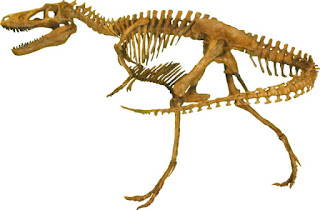Nanotyrannus is Actually T. Rex, Junior
Back in 1942, a small dinosaur skull was examined and classified as a relative of Tyrannosaurus rex. However, paleontologists did not have much to work with. Eventually, more parts were found as well as a nearly-complete skeleton in 2003 for Nanotyrannus. Upon further examination, it was determined that Nanotyrannus did not exist.
"You mean like Nanny Pelosi, Cowboy Bob?"
Ummm...sure. While Nanotyrannus was not real under that name, it turns out that it was a teenager. The first of the two articles features is shorter and focuses on the error of growth rings, which seems similar to dendrochronology. Since dinosaurs were unique and there was a lack of data, it should not come as a surprise that this method failed. Young dinosaurs like this one are considered by many creationists to have been on Noah's Ark, and they would have matured after the Flood.
Determining taxonomy has been problematic for a long time — especially for dinosaurs. There is prestige in making a discovery, but there have been many dinosaurs that have been reclassified as juveniles as well male and female of the same type. This is compounded by arrested growth patterns.
 |
| Credit: Wikimedia Commons / MCDinosaurhunter (CC by-SA 3.0) |
Ummm...sure. While Nanotyrannus was not real under that name, it turns out that it was a teenager. The first of the two articles features is shorter and focuses on the error of growth rings, which seems similar to dendrochronology. Since dinosaurs were unique and there was a lack of data, it should not come as a surprise that this method failed. Young dinosaurs like this one are considered by many creationists to have been on Noah's Ark, and they would have matured after the Flood.
A new analysis of a small pair of T. rex-like fossils, called Nanotyrannus, shows they were actually teenage T. rexes.To read the rest of the first article, click on "Teenage T. rex Fossils". The next article is more detailed.
Holly Woodward, from Oklahoma State University, and her colleagues reporting in Science Advances, counted the growth rings in the leg bones of the two Nanotyrannus specimens. Their results showed the specimens were not a new species. Rather, they were just 13 and 15-year-old T. rex dinosaurs.
Determining taxonomy has been problematic for a long time — especially for dinosaurs. There is prestige in making a discovery, but there have been many dinosaurs that have been reclassified as juveniles as well male and female of the same type. This is compounded by arrested growth patterns.
The latest research on one dinosaur called Nanotyrannus (Nano- or dwarf and tyrannus or tyrant) has finally firmed up what it was, a teenage T rex. Most of our information was known primarily from a single proven specimen, CMNH 7541. It was originally believed to be a new distinct genus based on a handful of cranial and postcranial features. Now, additional research on the creature’s bone tissue confirms it was merely a juvenile T. rex. The story of arriving at this conclusion is a good example of a big problem in the science of taxonomy, namely determining what is (or is not) a new species. This case also illustrates the problem of extrapolating conclusions about evolution from the fossil record.To finish reading, click on "Kid dinosaur was misidentified as a new species".
The problem is actually central in documenting evolution. What one may conclude is a transitional form between one species and a more evolved species may well be only a juvenile of a known species, and not a new species. Paleontologists admit that “despite its iconic status as the king of dinosaurs, Tyrannosaurus rex biology is incompletely understood,” even though since its discovery in 1905 the famed King of Dinosaurs “was met with intense scientific interest and public popularity, which persists to the present day.”